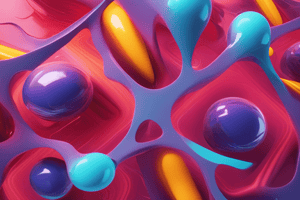Podcast
Questions and Answers
What is the best method for separating two or more immiscible liquids or solvents?
What is the best method for separating two or more immiscible liquids or solvents?
- Simple Distillation
- Evaporation
- Chromatography
- Differential Extraction (correct)
What is the principle of crystallization based on?
What is the principle of crystallization based on?
- Difference in boiling points
- Difference in color
- Difference in solubility of compounds and their impurities (correct)
- Difference in density
What is the best method for separating solid-solid miscible mixtures?
What is the best method for separating solid-solid miscible mixtures?
- Crystallization
- Sublimation (correct)
- Filtration
- Sedimentation
What does the Rf value represent in chromatography?
What does the Rf value represent in chromatography?
What is the best method for separating liquid-solid immiscible mixtures?
What is the best method for separating liquid-solid immiscible mixtures?
What is the purpose of separation techniques in organic chemistry?
What is the purpose of separation techniques in organic chemistry?
What is the best method for separating liquid-liquid miscible mixtures?
What is the best method for separating liquid-liquid miscible mixtures?
What is the stationary phase in chromatography?
What is the stationary phase in chromatography?
What is the mobile phase in chromatography?
What is the mobile phase in chromatography?
What is the best method for separating solid-solid immiscible mixtures?
What is the best method for separating solid-solid immiscible mixtures?
Study Notes
Liquid-Liquid Separation
- Separation of two or more immiscible liquids or solvents is best done using differential extraction with a separating funnel.
- Distillation methods used include vacuum, steam, fractional, destructive, and simple distillation.
Chromatography
- Chromatography techniques used include thin layer, gas, paper, column, and HPLC.
- Retention factor is a key concept in chromatography.
- Mobile phase and stationary phase (solid) are essential components of chromatography.
- Stationary phase can be either polar or non-polar, e.g., cellulose, silica gel, alumina.
- Rf value is calculated by dividing the distance of the sample by the distance of the solvent.
Purification of Organic Compounds
- Organic compounds need to be purified to obtain a useful product for applications such as pharmaceuticals, biomedicals, tissue engineering, and cosmetics.
- Separation techniques used depend on the nature of the mixture, which can be miscible or immiscible.
- Mixtures can be classified into four types: liquid-liquid (miscible), solid-solid (miscible), solid-solid (immiscible), and liquid-solid (miscible or immiscible).
Separation Techniques
- Liquid-liquid (miscible): simple distillation or chromatography are the best methods.
- Solid-solid (miscible): sublimation is the best method of separation.
- Solid-solid (immiscible): winnowing and magnetic separation are the best methods.
- Liquid-solid (miscible): evaporation, crystallization are the best separating methods.
- Liquid-solid (immiscible): decantation, filtration, sedimentation are the best methods.
Crystallization
- Crystallization is based on the difference in solubility of the compounds and their impurities.
- Impure compound is dissolved in a solvent in which it is partially soluble at room temperature but appreciably or completely soluble at higher temperatures.
- Solution is concentrated to get a nearly saturated solution, and on cooling, the compound crystallizes out and is removed by filtration.
- Colored impurities in the solution can be removed by adsorption using activated charcoal.
- Example: impure benzoic acid can be purified by dissolving in hot water, adding activated charcoal to adsorb impurities, filtering the solution, and then crystallizing the solution by allowing it to cool down.
Studying That Suits You
Use AI to generate personalized quizzes and flashcards to suit your learning preferences.
Description
Learn about the methods used to separate immiscible liquids, including differential extraction and distillation. Also, understand the principles of chromatography, including retention factor and mobile and stationary phases.




